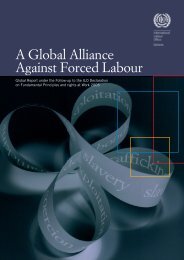equal by law, unequal by caste - International Dalit Solidarity Network
equal by law, unequal by caste - International Dalit Solidarity Network
equal by law, unequal by caste - International Dalit Solidarity Network
You also want an ePaper? Increase the reach of your titles
YUMPU automatically turns print PDFs into web optimized ePapers that Google loves.
Vol. 26, No. 2 Equal <strong>by</strong> Law, Un<strong>equal</strong> <strong>by</strong> Caste 313The examples of a <strong>Dalit</strong> chief minister, 318 a former <strong>Dalit</strong>president, 319 and the current <strong>Dalit</strong> Chief Justice of the Supreme Court ofIndia 320 are called upon to symbolize far more than they represent—evidence of real <strong>equal</strong>ity for <strong>Dalit</strong>s in India today. Such figures are onthe fingertips of those who critique accounts of widespreaduntouchability, exploitation, and violence against <strong>Dalit</strong>s as “unbalanced.”How the identification of a handful of examples balances the treatmentof over 167 million people as sub-human is left unquestioned as thecurious mathematical feat that it represents. As is often the case in othercountries, the existence of the exception is enough to swallow the rule.Rather than strengthening the argument that such few examples confirmthe sluggish pace of change, they are offered as proof positive of thesuccess of legal reform.According to a 1996 estimate, only 1.1 million out of the thenpopulation of 138 million <strong>Dalit</strong>s were employed in sectors that fell underthe domain of reservations, a paltry 0.8 percent. 321 With the privatizationof public sector industries since the advent of economic reforms in Indiain the early 1990s, that percentage has likely declined. 322 For the minutepercentage that has been able to escape the confines of poverty,reservations represent the only viable path to economic liberation and theembodiment of hope for many <strong>Dalit</strong>s that a slice of the economic pie is“reserved” for them. Reservations are an entry point, an opening of thedoor to institutions that were historically sealed shut <strong>by</strong> the <strong>caste</strong> system.Though limited in their reach and their effect, research suggeststhat reservations for <strong>Dalit</strong>s in political representation, publicemployment, and education have benefited those whom the policies wereable to reach. 323 Supporters of reservations argue that without affirmative318 See Profile of Ms. Mayawati, Chief Minister of Uttar Pradesh (Oct. 6, 2007),http://www.upgov.nic.in/upinfo/Ms_%20Mayawati%20_English_%20Biodata.pdf.319 Mr. K.R. Narayanan held the position of the President of India from 1997-2002, and was India’sfirst and only <strong>Dalit</strong> President. He passed away in November 2005. See Profile of Mr. K.R.Narayanan, (October 6, 2007), available at http://presidentofindia.nic.in/formerpresidents.html(last visited Aug. 16, 2008).320 See Profile of Justice K.G. Balakrishnan, Chief Justice of India (Oct. 6, 2007),http://www.supremecourtofindia.nic.in/judges/bio/sitting/bkgopinathan.htm (last visited Aug. 16,2008). Balakrishnan is India’s First <strong>Dalit</strong> Chief Justice. Balakrishnan is India’s First <strong>Dalit</strong>Chief Justice, EXPRESS INDIA, Jan. 14, 2007,www.expressindia.com/fullstory.php?newsid=79647 (last visited Aug. 16, 2008).321 Teltumbde, supra note 152, at 3.322 Jogdand, supra note 317, at 319, 328.323 See, e.g., John M. Alexander, In<strong>equal</strong>ity, Poverty and Affirmative Action: Contemporary Trendsin India 30-31 (Paper Prepared for the WIDER Conference: In<strong>equal</strong>ity, Poverty and HumanWell-being, United Nations University, Helsinki, Finland) (May 2003) available at
















